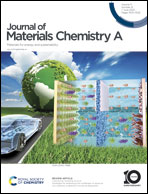In–Bi bimetallic nanofibers with controllable crystal facets for high-rate electrochemical reduction of CO2 to formate†
Abstract
Electrocatalytic carbon dioxide (CO2) reduction reactions (ECO2RRs) to form formate with high faradaic efficiency (FE) and production rate by renewable electricity are ideal to control CO2 concentration in the atmosphere. In this work, we successfully prepared bimetallic BixIny nanofiber (NF) catalysts with interconnected 3D network structure and controllable growth direction of crystal facets via electrospinning and the following electrochemical reduction for the first time, rendering a significantly increased InBi (200) lattice plane proportion in Bi5In5 NFs, which facilitated the improvement of intrinsic catalytic activity and formate selectivity for ECO2RR catalysts, as evidenced by crystalline characterization and DFT calculations. Consequently, the obtained Bi5In5 NFs achieve a maximum FE of 96.8% for formate and the corresponding production rate can reach 4.55 mmol h−1 cm−2, superior to most of the formate producing catalysts. This work provides a novel approach for preparing bimetallic catalyst NFs with high FE and product selectivity; moreover, the favorable productivity brings substantial application potential in industrial production.

- This article is part of the themed collection: #MyFirstJMCA


 Please wait while we load your content...
Please wait while we load your content...